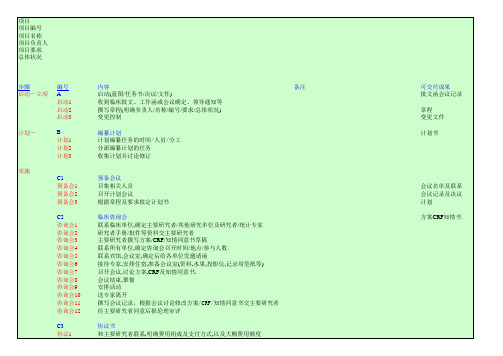临床试验项目管理用timeline模板
- 格式:xls
- 大小:27.00 KB
- 文档页数:1


专业合同封面COUNTRACT COVER20XXP ERSONAL甲方:XXX乙方:XXXCRA临床试验2024年度项目进度跟踪与评估合同本合同目录一览1. 项目概述1.1 项目名称1.2 项目编号1.3 项目类型1.4 项目起始日期1.5 项目结束日期2. 双方义务与责任2.1 甲方义务2.1.1 提供试验药物2.1.2 提供相关试验资料2.1.3 负责试验的推广与招募2.2 乙方义务2.2.1 跟踪项目进度2.2.2 定期评估项目进度2.2.3 提供项目进度报告3. 项目进度跟踪3.1 跟踪方法与工具3.2 跟踪周期3.3 跟踪数据来源4. 项目进度评估4.1 评估方法与指标4.2 评估周期4.3 评估报告格式与提交时间5. 沟通与协调5.1 双方沟通渠道5.2 协调机制6. 保密条款6.1 保密内容6.2 保密期限6.3 违约责任7. 争议解决7.1 争议解决方式7.2 仲裁地点与机构8. 合同的生效、变更与终止8.1 合同生效条件8.2 合同变更条件8.3 合同终止条件9. 违约责任9.1 甲方违约责任9.2 乙方违约责任10. 合同的解除10.1 解除条件10.2 解除程序11. 法律适用与争议解决11.1 法律适用11.2 争议解决方式12. 其他条款12.1 合同的修改与补充12.2 合同的优先级12.3 第三方受益人13. 合同的签署与备案13.1 签署地点与日期13.2 备案程序14. 附件14.1 项目详细方案14.2 试验药物相关资料14.3 其他相关文件第一部分:合同如下:第一条项目概述1.1 项目名称:CRA临床试验2024年度项目1.2 项目编号:CRACT20240011.3 项目类型:临床试验进度跟踪与评估1.4 项目起始日期:2024年1月1日1.5 项目结束日期:2024年12月31日第二条双方义务与责任2.1 甲方义务2.1.1 提供试验药物:甲方应按照合同约定的时间和数量,向乙方提供符合国家相关法律法规及临床试验要求的试验药物。



新药临床试验项目进度报告根据新药临床试验项目的要求,本报告旨在全面、准确地向相关方分享项目进展情况。
本报告详细记录了新药临床试验项目的计划、目标、进展情况以及可能面临的挑战,以便各方能够全面了解项目的进度和未来发展方向。
一、项目简介项目名称:新药临床试验项目项目起止时间:20XX年X月X日至今项目负责人:XXX二、项目目标本项目的目标是评估新药的疗效、安全性和适用性,为新药的上市提供临床数据支持。
具体目标如下:1. 收集和分析新药在临床试验过程中的中间结果和重要数据;2. 验证新药对疾病的疗效,评估药物的安全性;3. 评估新药的适用性和剂量范围;4. 达到并维持试验对象的合规性和伦理审查要求。
三、项目进展情况1. 临床试验设计本项目采用随机、双盲、安慰剂对照的方法进行临床试验。
试验设计已经完成,并得到了专家委员会的审批。
2. 试验对象招募为确保试验数据的准确性和可靠性,我们严格按照招募标准,通过多种渠道积极筛选合适的试验对象。
目前已完成试验对象的招募,招募过程中未出现重大问题。
3. 试验执行临床试验的执行过程中,我们精心组织、安排试验过程,确保数据的准确性和可靠性。
临床试验已经正常进行,并按照试验计划和伦理审查要求进行监管。
4. 数据分析试验数据已经完成收集,并由专业的数据分析团队进行统计和分析。
初步结果显示,新药在某些指标上具有明显的疗效,并且安全性符合预期。
5. 安全性监测试验期间,我们密切关注试验对象的安全情况,并及时记录和上报任何不良反应。
目前,试验对象的整体安全情况良好,未发现严重不良事件。
6. 进度和时间控制项目进展情况与初期计划相比,整体进度符合预期。
我们严格按照时间节点进行进度控制,确保项目的顺利进行。
四、面临的挑战和解决方案1. 招募困难:由于试验对象的招募标准较为严格,可能会面临招募困难的问题。
针对此问题,我们通过增加招募渠道、加强宣传等方式积极应对。
2. 不良反应的处理:在临床试验过程中,可能会出现不良反应的情况。

临床试验项目质控检查表
1. 项目基本信息
2. 准备阶段保存文件
文件目录参考GCP法规;研究者空格部分不强制要求;适用于项目启动前;研究文件保存于研究团队,必要时在机构备案,项目结束时均保存于机构办公室
3. 研究者
4. 受试者
5. 知情同意
6. 原始资料填写
7. 病例报告表
8. 试验用药物
9. CRA和CRC
10. 不良事件(AE)与严重不良事件(SAE)管理
备注:
1、检查不只限于表中内容,项目运行中出现任何问题都可以记载于该表中,且须详细记载。
2、医疗器械临床试验质量检查参照药物临床试验进行。
临床试验项目质控检查表
11. 项目基本信息。
临床试验英文方案模板Title: Clinical Trial English Protocol TemplateIntroduction:Clinical trials play a crucial role in the development and evaluation of new medical interventions, ranging from drugs to medical devices. An effective clinical trial protocol serves as a blueprint for the entire study, outlining the objectives, design, methodology, and analysis plan. This article aims to provide a comprehensive template for an English clinical trial protocol, ensuring clarity, consistency, and adherence to international standards.1. Title and Abstract:1.1 Title: Provide a concise and informative title that reflects the study's purpose.1.2 Abstract: Summarize the study's background, objectives, methods, and expected outcomes.2. Introduction:2.1 Background and Rationale: Describe the scientific and clinical basis for the study, highlighting the need for the intervention being investigated.2.2 Study Objectives: Clearly state the primary and secondary objectives of the study, including any exploratory or safety endpoints.3. Study Design:3.1 Study Type: Identify the study design (e.g., randomized controlled trial, observational study, etc.).3.2 Study Setting: Specify the study location(s) and the characteristics of the study population.3.3 Sample Size Calculation: Explain the rationale and methodology used to determine the sample size required to achieve study objectives.3.4 Randomization and Blinding: Describe the randomization process and any blinding procedures implemented.3.5 Data Collection and Management: Detail the data collection methods, data management procedures, and quality control measures.4. Participants:4.1 Inclusion Criteria: Clearly define the characteristics that potential participants must possess to be eligible for the study.4.2 Exclusion Criteria: Identify the characteristics that would exclude potential participants from the study.4.3 Recruitment and Informed Consent: Describe the recruitment strategies and the process for obtaining informed consent from participants.5. Intervention:5.1 Study Treatment: Provide a detailed description of the investigational intervention, including dosage, administration route, and frequency.5.2 Comparator: If applicable, describe the control group or the standard treatment against which the intervention will be compared.5.3 Concomitant Medications: Specify any allowed or prohibited concomitant medications during the study period.6. Study Outcomes:6.1 Primary Outcome(s): Clearly define the primary outcome(s) and the methodology for assessing them.6.2 Secondary Outcome(s): List and describe any secondary outcomes, including their assessment methods.6.3 Safety Measures: Explain the procedures for monitoring and reporting adverse events or safety concerns.7. Statistical Analysis:7.1 Data Analysis Plan: Provide a detailed description of the statistical methods that will be used to analyze the data.7.2 Interim Analysis: Specify any planned interim analyses, including stopping rules for efficacy or safety.7.3 Handling of Missing Data: Describe the approach to handling missing data in the analysis.8. Ethical Considerations:8.1 Institutional Review Board (IRB): State that the study will be conducted in compliance with the local IRB and ethical guidelines.8.2 Informed Consent: Explain how the informed consent process will be carried out, ensuring participant autonomy and privacy.8.3 Data Protection: Outline the measures taken to protect the confidentiality and integrity of participant data.9. Study Timeline:9.1 Study Duration: Estimate the overall duration of the study, including participant recruitment, intervention, and follow-up.9.2 Study Milestones: Provide a timeline for key study milestones, such as the start and completion of data collection and analysis.10. Dissemination of Results:10.1 Publication Policy: Describe the plan for disseminating study results, including the intended target audience and the timeline for publication.10.2 Authorship: Define the criteria for authorship and the process for assigning authorship on study publications.Conclusion:A well-designed clinical trial protocol is essential for conducting rigorous and ethical research. By following this template, researchers can ensure consistency and transparency in their clinical trial protocols, facilitating the evaluation and replication of study findings. It is crucial to adapt the template to the specific requirements and guidelines of thestudy's regulatory authority and ethical committee.。
临床试验启动会议纪要Initiation Meeting Minutes Subject:临床试验启动会主题Date:日期Venue:地点Participants:见会议签到表Meeting Attendance Record 出席人员Preparedby:记录员启动会主要内容记录(请根据试验项目要求进行记录,可附页)附件:1、会议签到表2、方案签字页(研究者签名样张)3、任务授权表会议签到表Meeting Attendance Record方案签字页(签名样张)I have thoroughly read and reviewed the study protocol. Having read and understood the requirements and conditions of the study protocol. I agree to conduct or instruct this project and follow the time schedule indicated in protocol. I understand that it is protocol violation if revise the protocol without approval from Ethic committee.我已完全阅读了研究方案,并明白了方案的要求。
我同意遵循方案及时间规程来执导该项临床研究。
我亦知道没有伦理委员会的批准就修改方案是违反方案的。
I agree to perform the clinical study according to the Chinese GoodClinical Practice principles and regulatory authority requirements for source document verification and auditing/inspection of the study.我同意按中国GCP原则进行临床试验,并接受法规部门对原始资料的核查和对临床试验的稽查/视察。